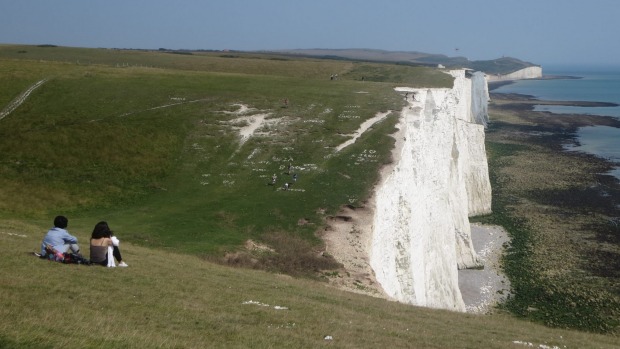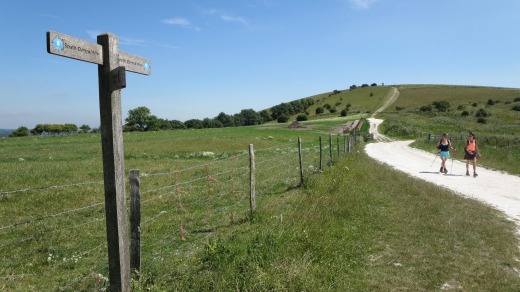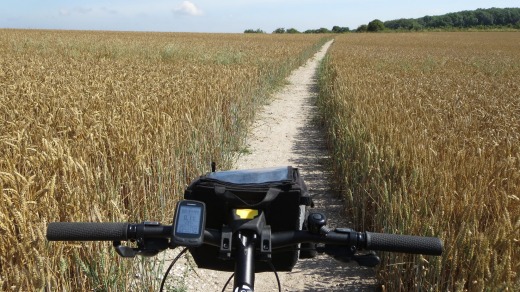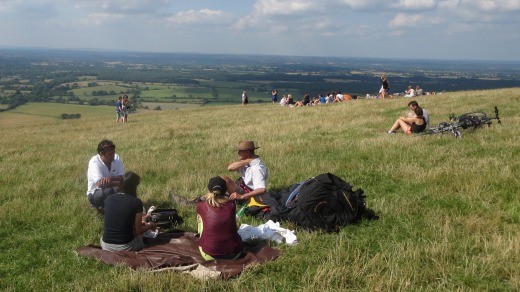
Of all the things I feared might thwart my attempt to cycle England's South Downs Way, cows weren't among them. Yet here I am, prevented from continuing by a closely packed bovine scrum.
Vigorous shooing does nothing but encourage more to wander over and block the gate. In desperation, I wave a towel around my head while shrieking like a demented Morris dancer. The cows scatter and I turn around to discover two grinning cyclists taking photos.
The South Downs Way (SDW) is a 160-kilometre trail from Winchester in Hampshire to Eastbourne in Sussex. It runs along the top of the South Downs, an undulating range of chalk hills that became England's newest national park in April 2011.

Most people walk the SDW over eight days but it's also accessible by bike.
The adventure starts in a Winchester car park where Rob Stanley, from Walk and Cycle, gives me a shiny 27-speed mountain bike and takes my overnight bag, which he'll transfer between the accommodation each day.
I've given you a padded saddle. You'll thank me for it later.
Rob Stanley
"I've given you a padded saddle," he says, smiling knowingly. "You'll thank me for it later."

I set off towards Winchester City Mill, the trail's official start point, and immediately get swept up by the city's one-way system. I finally locate the mill straddling the River Itchen.
The trail's wooden signposts direct me across a bridge, along a meandering gravel path and to a freshly shorn wheat field dotted with golden bales of straw. It's liberating to be able to stop whenever you like but disconcerting not to have a guide or a support vehicle. I console myself with the fact that people have been walking this track for more than 5000 years.
It's perfect cycling weather – no wind, clear skies and an unseasonably warm 27 degrees.

I ride for two hours before seeing another soul, and it's at an opportune juncture. I'm about to open a gate and head down a narrow, bramble-lined path when two cyclists round the corner. "Don't go that way," says one, pointing to a sign almost totally obscured by the hedgerow. "We didn't see it either."
It's the first of several navigational near-misses. When you're whizzing along admiring the scenery, it's all too easy to miss a vital trail marker. I've borrowed a GPS and half a dozen times it saves me from a wrong turn.
The path climbs to the summit of Beacon Hill, one of several hills where bonfires were lit in 1588 to warn of the incoming invasion by the Spanish Armada. Now it's a National Nature Reserve, a picturesque grassy knoll home to 13 species of orchids and several Bronze Age burial grounds.
Hills are an unfortunate defining feature of the South Downs. There are 10 peaks higher than 210 metres and many of the ascents are brutal thigh-burners. Adding to the challenge is that the route is almost entirely off-road, on teeth-jarring, bone-dry chalk paths studded with flint and tree roots.
At 2.30pm it's a quick stop in East Meon for lunch. Worryingly, I'm only halfway to my accommodation, so must push on.
The highlight of the afternoon is a sweeping, high-speed descent through a grassy meadow in Queen Elizabeth Country Park. Of course, what goes down must eventually go back up, and the calf-cramping climb to Harting Down is particularly testing.
I finally reach the steep drop-off into pretty Graffham village and limp into the welcoming embrace of The Foresters Arms at 7pm. One hot shower, two glasses of rioja and a delicious dinner of slow roasted pork belly later, and I'm almost human again.
The next day, after climbing back up onto the ridgeline, I'm bathed in warm sunshine and skirting hedgerows alive with butterflies and birdsong.
I pass Chanctonbury Ring, the site of a 5th-century BC hill fort, and Devil's Dyke, a striking steep-sided valley named after a legend claiming it was dug by the Devil in an attempt to destroy the area's churches.
Overnight is at the delightful Pelham House in Lewes, a historic town lined with pastel-hued houses and an impressive 11th-century Norman castle.
Dinner in Pelham House's sculpture-filled garden is a decadent splurge of smoked trout, sirloin steak and Valrhona chocolate fondant, more than enough to replenish the 2559 calories my GPS claims I expended today.
The final day heads towards the coast and the landscape morphs from manicured farmland, the scene of my embarrassing bovine encounter, to undulating grass hills. Overhead, seagulls and paragliders circle in the stiff sea breeze.
After lunch in the adorable Badger's Tea House, in the picturesque hamlet of Alfriston, I'm faced with a choice: take the designated cycle trail to the end point at Eastbourne or ignore the "No Bikes" signs and take a more scenic walking trail through Cuckmere Valley and along the Seven Sisters sea cliffs.
It seems a shame to come this far and not see Beachy Head, Britain's highest chalk sea cliff, so the latter it is. Little did I know I'd have to lift the bike over a dozen stiles and up two flights of stairs, but the towering cliffs and spectacular sea views are an appropriately dramatic finale.
I reach Eastbourne seafront at 5pm to find Rob waiting with his van. We load up the bike and he smiles as I gingerly lower myself into the passenger seat.
Later, I discover the record for cycling the 160 kilometres is an astonishing seven hours 50 minutes. Something tells me whoever achieved that didn't need a padded saddle.
TRIP NOTES
MORE INFORMATION
GETTING THERE
British Airways flies from Sydney and Melbourne to London, see britishairways.com. There are direct train services from London to Winchester and Eastbourne, see nationalrail.co.uk.
CYCLING THERE
Walk and Cycle can provide bike hire, luggage transfers and itinerary advice, see walkandcycle.co.uk.
STAYING THERE
Foresters Arms, Graffham, rooms from $160, see forestersgraffham.com. Pelham House, Lewes, rooms from $255, see pelhamhouse.com.